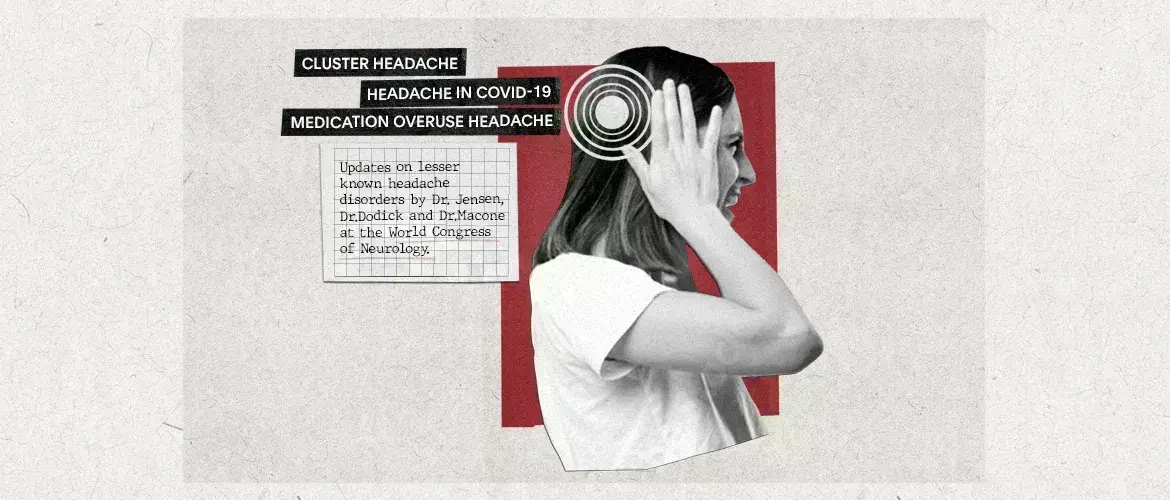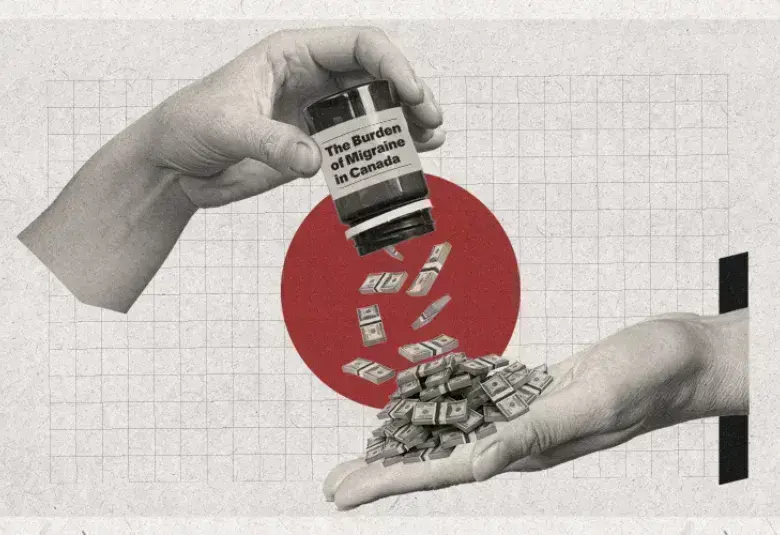Migraine receives a lion’s share of attention in the popular media and in neurological congresses because it is highly prevalent and there have been recent treatment innovations, such as the calcitonin gene-related peptide (CGRP) blocking agents. While other types of headache disorders may be less common, they may nonetheless carry a high disease burden. During a session devoted to lesser known headache disorders at the World Congress of Neurology (WCN) 2023 in Montreal on October 17th, 2023, world leading experts shared their insights and latest evidence on cluster headache, medication overuse headache (MOH) and COVID-19 associated headache.
Cluster Headache
Dr. Rigmor H. Jensen, a professor of neurology and Director of the Danish Headache Center in Copenhagen, addressed the burden and management of cluster headache. This disease has been described by patients as being intensely painful and different from migraine attacks. Although relatively rare (~0.1% prevalence rate),1 cluster headache is often misdiagnosed and mismanaged. One of the key distinguishing features of cluster headache is a sense of restlessness or agitation, whereas migraine attacks often compel individuals to lie still. Other unique features of cluster headache include the fast onset of attacks (i.e., within minutes), which makes it difficult to initiate early treatment, and chronobiology. Cluster headaches often occur in the early hours of the morning (i.e., around 1:00 or 2:00 a.m.), and there is a seasonal pattern to cluster attacks (i.e., they are inversely related to the duration of daylight).
Cluster headache has been described as ‘suicidal headache’ due to the extreme intensity of pain
One of the challenges in studying cluster headache is the inability to initiate attacks in animal or human models. Consequently, there have been relatively few advancements in the treatment of cluster headache in the last 15 years, and current strategies still rely on older medications including steroids, calcium channel blockers, oxygen therapy, and triptans. Trials are underway investigating the potential for anti-CGRP monoclonal antibodies as preventive therapies in patients with episodic and chronic cluster headache (chronic cluster headache is characterized by persistent attacks for >1 year without remission, or remission lasting <3 months without preventive medication2). Other potential targets such as pituitary adenylate cyclase-activating peptide (PACAP) and vasoactive intestinal peptide (VIP) are being investigated. Dr. Jensen concluded that there remains a huge unmet need for better treatment of cluster headache.
Medication Overuse Headache (MOH)
Dr. David Dodick, Professor Emeritus at the Mayo Clinic Atrial Institute, presented some recent evidence that provides new insight into the management of MOH. Medication overuse (MO) can occur without meeting diagnostic criteria for MOH. Indeed, it has been estimated that almost one in five individuals with migraine overuse acute medications whereas prevalence rates of MOH are lower.3 Cohort studies have identified a few strong risk factors for MOH, which include greater migraine severity, obesity, smoking, and concomitant anxiety and depressive disorders. Dr. Dodick underscored the importance of identifying these risk factors in clinical practice to reduce the risk of MOH through patient education, non-pharmacologic interventions, and appropriate use of preventive medication. Some candidate gene and proteomic biomarkers are being investigated that could eventually help in the early identification of individuals at higher risk for MOH, but these are still in their infancy and require more research.
Emerging risk factors for MOH include genetic factors and serum and urine biomarkers
There is considerable variability with respect to acute medications and risk of MOH. Barbiturate and opioid containing compounds can induce MOH with as little as 4 to 6 days of use per month. On the other hand, triptans have a much lower risk of MOH, and nonsteroidal anti-inflammatory drugs (NSAIDs) may even be protective. To date, gepants are the only class of acute medications that may not have the potential to induce MOH.
When an acute medication is being overused, health care providers may consider switching to a gepant or an NSAID
Neuroimaging studies suggest that latent central sensitization associated with overuse of some acute medications is an important driver of MOH.4 Importantly, these pathways can be blocked with anti-CGRP agents, which explains in part their utility in the treatment and prevention of MOH.5 Other lines of evidence suggest that overuse of certain acute medications reduces the threshold for cortical spreading depression,6 which is known to be a clinical substrate for migraine aura. Finally, acute MO can impair descending pain inhibition pathways, which could amplify nociception and drive MOH.7
Neuroimaging studies are shedding new light on the pathophysiology of MOH
Dr. Dodick concluded his presentation by addressing one of the ongoing controversies in MOH management. Both withdrawal (‘detoxification’) and prevention are effective strategies for MOH, and there is evidence to support a combined strategy of withdrawal and prophylaxis at the same time. However, prevention without withdrawal can also be highly effective. Dr. Dodick advocated for more studies to address the optimal strategy for managing MOH and to provide guidance on how to individualize strategies in specific circumstances (e.g., in patients with concomitant anxiety).
Headache in COVID-19
Acute infection with SARS-CoV-2, the virus that causes COVID-19 disease, has been associated with myriad symptoms, including headache. Dr. Amanda Macone, a neurologist and headache specialist at the Beth Israel Deaconess Medical Center in Boston, shared some emerging insights on the characteristics and pathophysiology of COVID-19 headache, as well as vaccination-related headache.
Headaches are commonly associated with viral infections, including influenza and other coronaviruses. In acute COVID-19 disease, headaches appear to be more prevalent in females and in younger patients, and the onset is typically within 24 hours of infection. There is evidence to suggest that individuals with primary headache disorders are more susceptible to COVID-19 headache than those without, and that COVID-19 headache differs from their usual headaches: notably, COVID-19 headaches are earlier in onset, longer lasting, more intense, and more resistant to typical acute medications.
Headache in acute COVID-19 is often an early sign of infection
Although the pathophysiology of COVID-19 headache has not yet been fully elucidated, multiple mechanisms have been proposed, including direct viral invasion of the peripheral and central nervous systems, inflammatory response (i.e., the ‘cytokine storm’ associated with severe COVID-19 disease), and autoimmune responses. There are also secondary etiologies related to viral illness such as fever, hypoxia, dehydration, and metabolic disturbances, as well as external psychosocial factors related to the pandemic lockdown measures, such as stress and dysregulated sleep.
Anecdotally, headache can be a persistent symptom following COVID-19 disease in many individuals. Persistent headache appears to be more common in individuals who experience more severe headache during acute COVID-19 illness and in females, and it can co-exist with other persistent symptoms, such as fatigue, brain fog, and dyspnea.
About 30% of individuals report COVID-19 vaccination-related headache8
Dr. Macone briefly touched on COVID-19 vaccination-related headache, which is usually milder in intensity, lasts <24 hours, and is more responsive to analgesics. The type of vaccine administered may also impact headache risk.
COVID-19 remains an area of intense research, and Dr. Macone predicted that our understanding of COVID-19 headache will continue to evolve in the coming years.
Our correspondent’s highlights from the symposium are meant as a fair representation of the scientific content presented. The views and opinions expressed on this page do not necessarily reflect those of Lundbeck.




